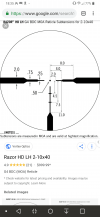archanfire
Well-Known Member
I am starting to look into BDC reticle scopes, and my biggest issue(that I see), are the majority seem to have exposed/non-locking turrets. So, my question is, why are exposed/non-locking turrets so common when the reticle does most(if not all) ranging and compensating for you? This question is more directed towards 'Christmas Tree' style scopes. My concern would be bumping the turrets(on hunt, competition, etc) and missing your mark when coming time to shoot.
Again, I am new to this concept, so be gentle
Thanks all
Again, I am new to this concept, so be gentle
Thanks all
Last edited:

